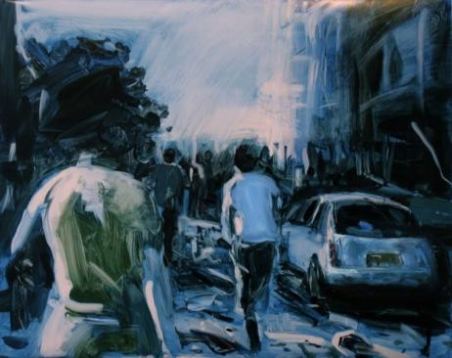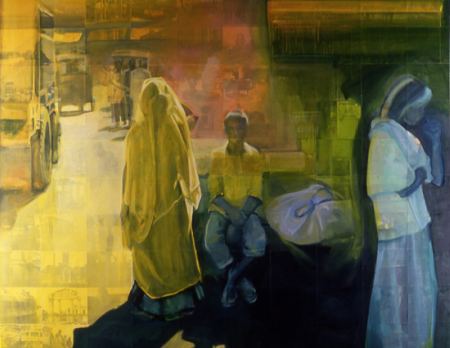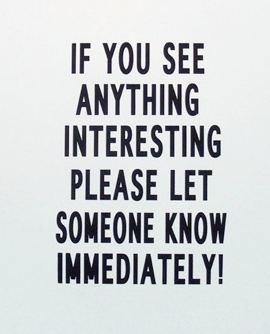
Archives for 2009
David Barnes & Randy Hayes – time layered
Evan Blackwell – in the frame
In 1978, Allan McCollum began a series of paintings (Surrogates) that were no more than extensions of the frame.
Evan Blackwell‘s paintings are the frames.
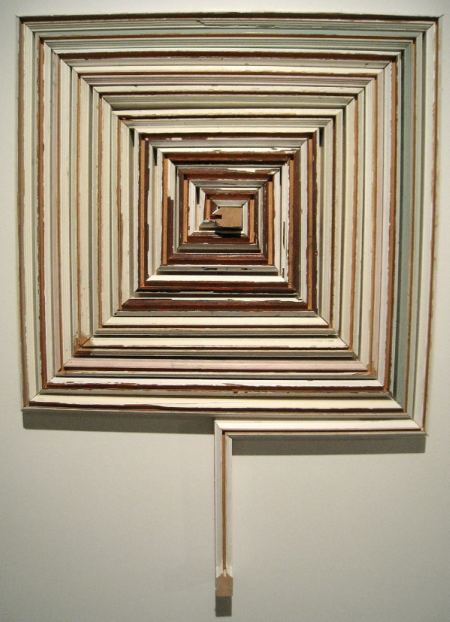
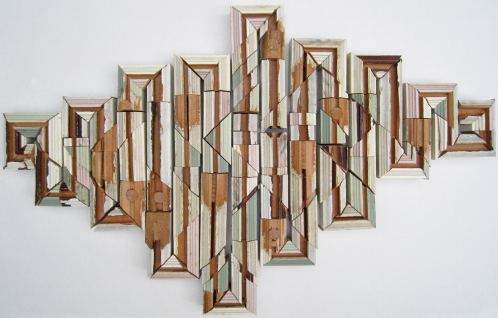 In his solo exhibit at Seattle’s 4Culture Gallery, Lost in Space, Blackwell proves (among his many other material explorations) that Tara Donovan isn’t the only artist coming up with new uses for drinking straws. Hers billow, like clouds. His are salvaged camouflage with a direct hit in the center. The center is your center, wherever you happen to be looking. It’s the illusion of a ripple effect.
In his solo exhibit at Seattle’s 4Culture Gallery, Lost in Space, Blackwell proves (among his many other material explorations) that Tara Donovan isn’t the only artist coming up with new uses for drinking straws. Hers billow, like clouds. His are salvaged camouflage with a direct hit in the center. The center is your center, wherever you happen to be looking. It’s the illusion of a ripple effect.
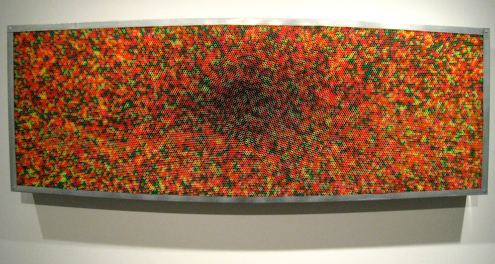 Blackwell graduated last year from the University of Washington with an MFA in sculpture.
Blackwell graduated last year from the University of Washington with an MFA in sculpture.
I am in the process of constructing forms, compositions, structures, and spaces that serve as lens to see both the materials from which they were constructed and world we live in with fresh perspective.
Through Nov. 27.
He who digs newspapers…
can sit on them. (Via)
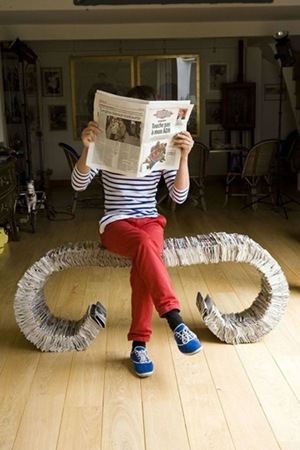
Lesbian media – pregnant with information
From Seattle’s Wynne Greenwood:
Hello! FEMINIST FORM, a new screening series, is starting next Saturday. Please come, it would be great to see you there! And tell your friends, family, colleagues, neighbors, lovers, teachers, partners…
FEMINIST FORM
presents video work by:
Wynne Greenwood and K8 Hardy
Saturday, November 21
Doors open at 7:30pm
Screening begins at 8pm
Hiawatha Artist Lofts Community Room
843 Hiawatha Pl. S
Seattle
$5 – $10 Sliding Scale
Suggested Donation.Chair seating is limited, please come early if you want to sit in a chair. Plenty of floor seating.
FEMINIST FORM is a screening series of feminist and queer media from the Pacific Northwest.
Wynne Greenwood and K8 Hardy have been collaborating since 2002. Included in the screening will be TV Lip Sync, 2002, and two videos from their ongoing project New Report, New Report, 2005, and the documentation of the live performance New Report: Morning Edition, in which the reporters hold an intimate deliberation on the objectification of the biological female body. This is the Seattle debut of this project. (This does contain graphic imagery.)
Please forward this announcement widely!
Looking forward to seeing you there.
All my best, Wynne

Peter Shelton and the peanut gallery
In the west plaza of Seattle’s Safeco Field is a 5-ton granite boulder that sculptor Peter Shelton found in the Cascade range. It’s an object with the power to bring wilderness into the city.
Shelton honored it with a shadow, a black bronze replica that offers mass without weight. Woven on its surface are horizontal waves that respond to the surface nuances of the rock and answer its chaos with order. Titled “rockshadow,” the piece plays with the nature of inside and out, form and shadow, the real and fake, the found and created.
Despite the challenge of his subtlety, Shelton enjoys considerable success in the realm of public art. Controversies such as the current one over his sixbeaststwomonkeys, an ensemble of eight sculptures installed in front of the LAPD’s new headquarters, are rare.
(Photos LA Times)
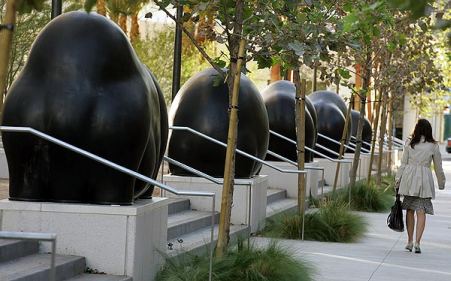
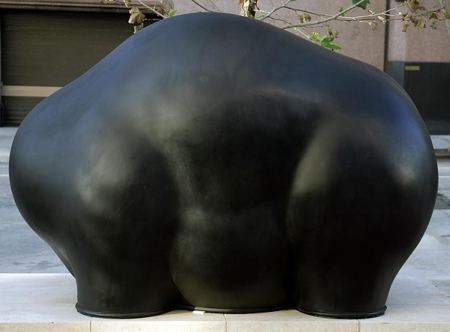 One of two bookends:
One of two bookends:
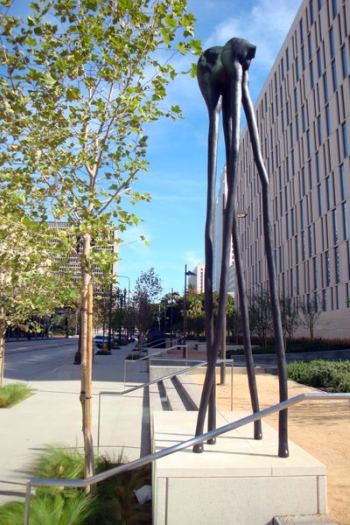 LA Times columnist Steve Lopez kicked off the commentary with one of his I-wander-the-city essays. In a similar vein, his columns on homeless musician Nathaniel Ayers became a book and later a movie starring Robert Downey Jr. and Jamie Foxx. (In case somehow you missed it, NPR story on their friendship here. Good movie.)
LA Times columnist Steve Lopez kicked off the commentary with one of his I-wander-the-city essays. In a similar vein, his columns on homeless musician Nathaniel Ayers became a book and later a movie starring Robert Downey Jr. and Jamie Foxx. (In case somehow you missed it, NPR story on their friendship here. Good movie.)
Here’s Lopez on Shelton:
As luck would have it, the nearly completed LAPD headquarters is right outside my office window, so I’ve been bird-dogging the project from Day One to make sure taxpayers don’t get ripped off. Which brings me to the $500,000 worth of public art that’s just been installed on the west side of the building.
The cast-bronze sculptures consist of six large black blobs, with two tall, skinny structures on either side.
I wasn’t sure what to make of them, so I went straight to the top: It looks like “some kind of cow splat,” said Police Chief William J. Bratton, who sounded as if he were personally insulted by the installation.
Bratton said he first drove past the work and later walked back to see whether “it’s as ugly up close as it is when you’re driving by.”The answer was yes, and he sounded mad enough to have the artist arrested.
Lopez’s aw-shucks style appears to preclude research. If he did any, it’s not obvious. LA Times art critic Christopher Knight had to respond, but such responses are tricky. Knight cannot shoot inside his own building. While he can be tough as he wants on targets outside the Times, inside he treads lightly.
Meth labs and Project Runway
In art, meth lab imagery tends to engage the DIY spirit of the outlaws. In an art context, before they are outlaws, they are makers. Claiming them is radical, but possibly no more radical than artists’ interest (now fading) in Project Runway. From high fashion to low crimes, enterprises that require the skill of the hand attract artists, even those whose practice calls for them to delegate fabrication to others.
As installations, meth labs fascinate, which can’t be said of PR. The problem with the current season is not the move to LA, although it didn’t help. It’s not the sporadic appearance of the New York judges, who are disinclined to make the trip. That didn’t help either. And it’s not the goofy challenges. There have always been goofy challenges.
It’s the poor quality of the contestants. Where did PR get these people? Of the final three, only Carol Hannah Whitfield has possibilities, and they dim compared to finalists in previous years. As for Irina Shabayeva, she projects shallow luxury, while Althea Harper projects not much of anything.
Meth labs, however, always have possibilities, being made and wrecked at the same time.
Meth kills, but so does moralism. Think of where we might be if the U.S. government had paid Afghan farmers for their poppy crops instead of burning their fields. Once in control of the product, we could have used it for medical pain relief in the Third World, where surgeries without anesthetics are too common. For a fraction of the cost of killing them, we could have helped the poorest of the poor raise their standard of living.
And if, in the U.S., drug abuse were a medical and not a criminal problem, those who construct the labs would be reduced to making something else. Art, for instance.
Jonah Freeman, Justin Lowe and Alexandre Singh
Hello Meth Lab in the Sun #1, 2008
custom pigment print
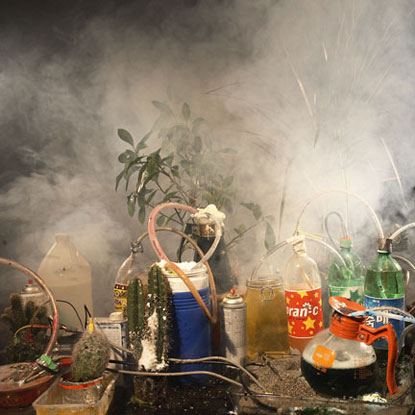 Eli Hansen, I’m not paranoid because I’m high, 2009
Eli Hansen, I’m not paranoid because I’m high, 2009
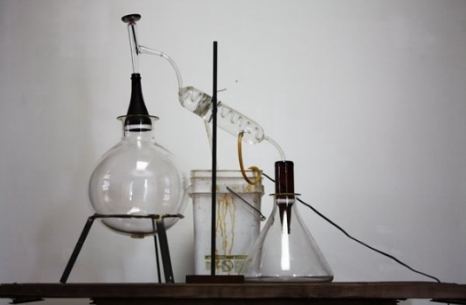 Davis Langlois Meth Lab, 2003, oil/canvas
Davis Langlois Meth Lab, 2003, oil/canvas
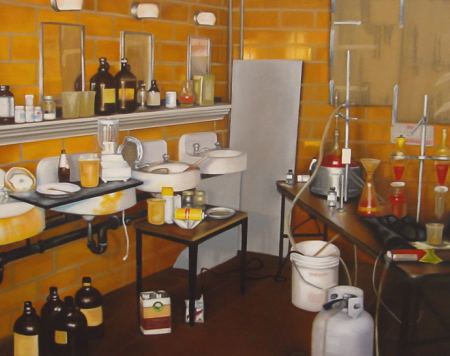
Vija Celmins to Andrew Witkin: fool the eye
Vija Celmins is known for her small output interrupted by long silences. To admire her work is to lose one’s taste for charm. Her early still lifes are full of an understated yet powerful dread. Her later seascapes, desert floors and night skies look like the world seen through the eyes of the dead.
From 1977 to 1982, she paired rocks she had picked up and saved with painted bronze replicas. Eleven pairs are at the Museum of Modern Art.
I got the idea for this piece while walking in northern New Mexico picking up rocks, as people do. I’d bring them home and I kept the good ones. I noticed that I kept a lot that had galaxies on them. I carried them around in the trunk of my car. I put them on window sills. I lined them up. And, finally, they formed a set, a kind of constellation. I developed this desire to try and put them into an art context. Sort of mocking art in a way, but also to affirm the act of making: the act of looking and making as a primal act of art. (more)
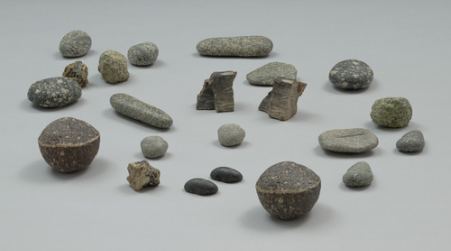 Fourteen years later, Andrew Witkin crafted his own pile of stones. Like Celmins’, his assortment is full of ringers. Unlike Clemins, he created his bleached bone pile for beauty’s sake. While hers is a challenge to the eye, his is a reassurance. All of it, from table tennis balls and bits of cork to stones and ceramic orbs, vibrates on the same visual frequency in order to fuse.
Fourteen years later, Andrew Witkin crafted his own pile of stones. Like Celmins’, his assortment is full of ringers. Unlike Clemins, he created his bleached bone pile for beauty’s sake. While hers is a challenge to the eye, his is a reassurance. All of it, from table tennis balls and bits of cork to stones and ceramic orbs, vibrates on the same visual frequency in order to fuse.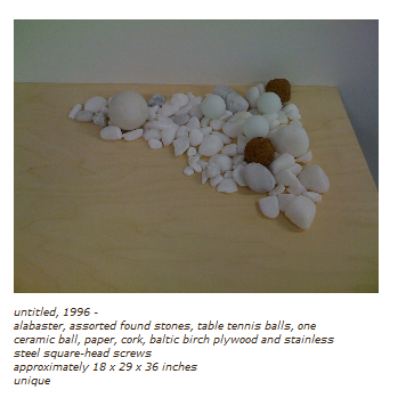
Weekend links – Seattle’s golden age
Jen Graves on Jeffry Mitchell, a breathtaking piece of writing, here.
Jeffry Mitchell’s art is ejaculatory, in
every good and holy and dirty and wrong sense of the word. We are
discussing this at church. Actually, we are outside church; we’ve just
come from the pews of St. Ignatius at Seattle University, where we
lifted our eyes up to the half-naked, tortured, and dead Christ, and
kept quiet.
Seattle could be entering its golden age of art criticism. There are more good writers covering visual art than ever before.
A psychotic need to deny: the Michael Jackson School of Art, here.
Beautiful math in architecture from Los Angeles County Museum on Fire, here.
Douglas Britt on Tilda Swinton, the actress most closely associated with the art world, here.
The best art is meaningless (Bob Dylan: “Walk tall and always carry a light bulb”) here.
In what way did Margarete Heymann differ from other Bauhaus pioneers? She was a woman unattached to a powerful male. Hence, her invisibility. Story here.
Real Clear Arts praises the new Whitney Web site, here.
Two Coats of Paint rejoices: “In the hierarchy of art, painting has always been at the top of the heap …,” here.
Jeff Weinstein on Our Great-Grandfather’s Butts, here.
Translinguistic Other salutes artist and art enthusiast Joey Veltkamp, here. If every town had a Joey Veltkamp, it would be a (much) better world.
Why is this piece from 2003 in The Guardian so much better than anything Sebastian Smee has written in the Globe?
Sample:
Sex has traditionally been the easiest way to distinguish between them:
where art nouveau had been feminine, art deco, the style that succeeded
it, was masculine. Feminine meant curves and organic forms, an orgy of
ornament; masculine meant straight lines, vitality, speed and
streamlining. When art deco kicked in before the first world war,
around 1910, the fine arts were still giddy from the revolutions of
fauvism, primitivism and cubism. But it really blossomed in the roaring
20s, the age of the flapper: in the collective imagination art deco
means women smoking, drinking cocktails and dressing like men.
He’s too young to have gone slack. I’d hate to conclude it’s a difference in editors. The Globe is famous for its editors.
Claire Cowie in a medieval vein
The European Dark Ages do not haunt a hearty strain of the contemporary imagination for its wars, famines, dreads and superstitions, but for its irrational certainties. Good and evil were as concrete in the world as a horse in a pasture, a baby crying in a house or a woman drowned in a well. By casting its shadow on the brightest of days, evil affirmed its presence. The struggle against it was constant, and risks extended into eternity.
What did that world look like?
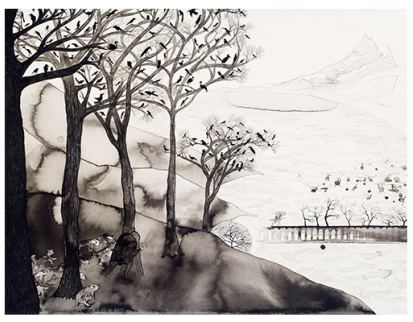
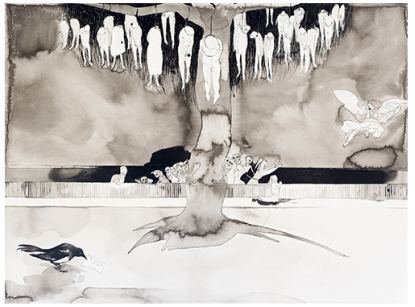 Claire Cowie‘s The Weeping and Gnashing of Teeth continues at Gage Academy through Saturday.
Claire Cowie‘s The Weeping and Gnashing of Teeth continues at Gage Academy through Saturday.
Death has always stalked Claire Cowie’s paintings and sculptures, but lately she’s taken it in and given it a furnished room in the parallel universe she’s been building for years.



